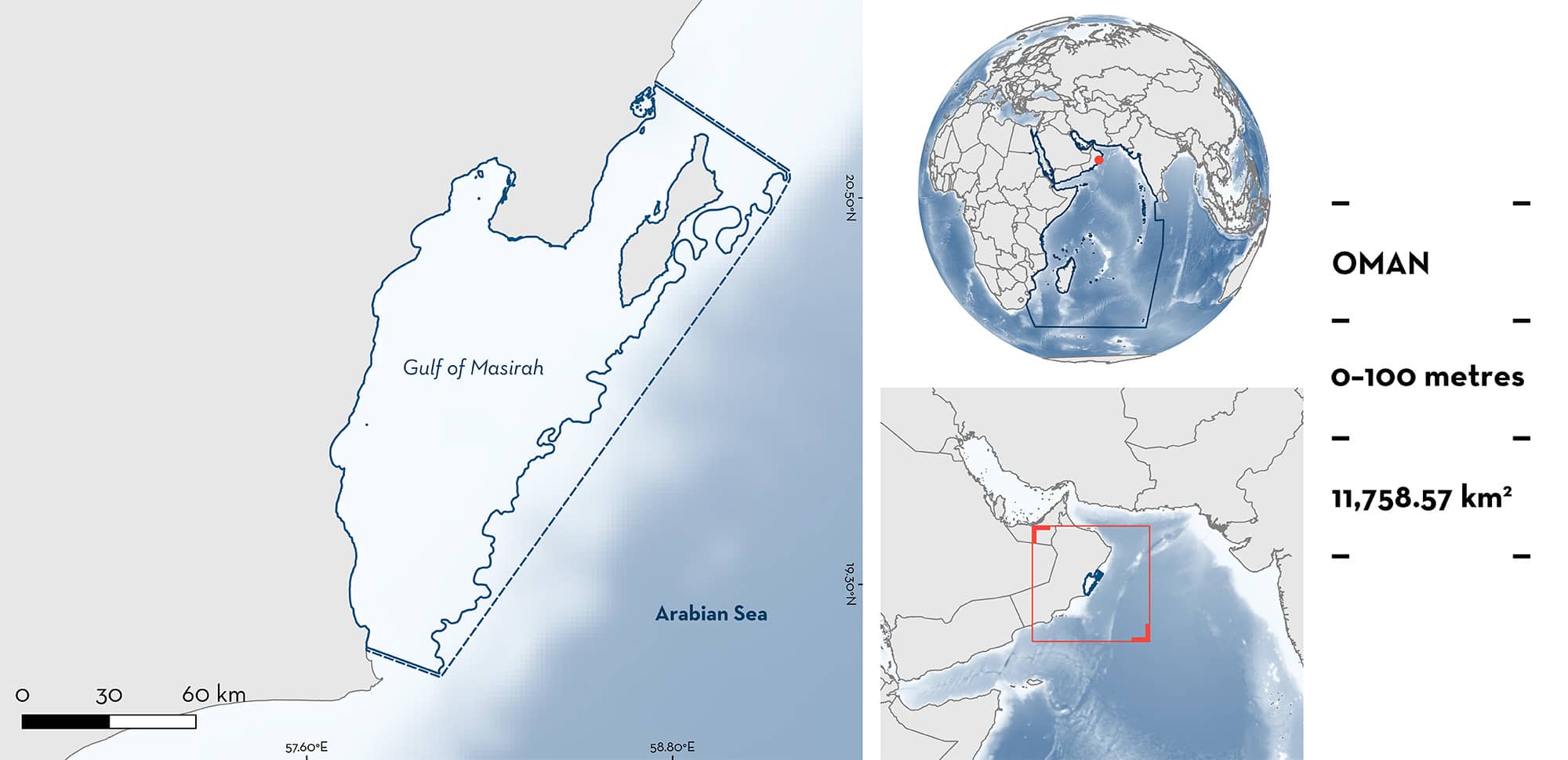ISRA FACTSHEETS
ISRA FACTSHEETS
WESTERN INDIAN OCEAN REGION
Gulf of Masirah
Summary
Gulf of Masirah is located in the Arabian Sea, in the Al Wusta Governorate of Oman. It extends from Masirah Island in the northern part to Ad Duqm in the south. The area is a large shallow embayment and is characterised by rocky and sandy areas, mangroves, seagrass beds, and coral reefs. Monsoon winds produce seasonal upwelling and cause an increase in productivity. This area overlaps with one protected area, two Key Biodiversity Areas, and one Ecologically or Biologically Significant Marine Area. Within the area there are: threatened species (e.g., Blacktip Shark Carcharhinus limbatus) and reproductive areas (e.g., Milk Shark Rhizoprionodon acutus).
Download factsheet
Gulf of Masirah
DESCRIPTION OF HABITAT
Gulf of Masirah is located in the Arabian Sea, on the southeastern coast of the Sultanate of Oman, in the Al Wusta Governorate. It extends from Masirah Island in the northern part to Ad Duqm in the south. The area is the largest shallow embayment along the coast of Oman, and is characterised by rocky and sandy areas, mangroves, seagrass beds, and coral reefs (Fouda & Ali-Muharrami 1995; Blue et al. 2014; Spreter er al. 2022).
The area is influenced by southwest monsoon winds (June–September) and northeast monsoon winds (December–March) producing a strong coastal current (Sheppard 2018). This current produces upwellings and causes an increase in productivity along the Arabian Sea (tenfold increases compared to inter-monsoon periods) and decreases in sea surface temperatures (~17°C) compared to the annual mean (~25°C; Sarma et al. 2013; Sheppard 2018; Willson et al. 2020).
This area overlaps with the Al Wusta Wetland Reserve, two Key Biodiversity Areas (KBA), Barr al Hikman and Masirah Island (KBA 2023a, 2023b), and the Oman Arabian Sea Ecologically or Biologically Significant Marine Area (EBSA; CBD 2023).
This Important Shark and Ray Area is benthopelagic and is delineated from inshore and surface waters (0 m) to 100 m based on the distribution of the Qualifying Species in the area and the maximum depth of the area.
CRITERION A
VULNERABILITY
Three Qualifying Species considered threatened with extinction according to the IUCN Red List of Threatened SpeciesTM regularly occur in the area. These are the Critically Endangered Scalloped Hammerhead (Rigby et al. 2019) and the Vulnerable Milk Shark (Rigby et al. 2020) and Blacktip Shark (Rigby et al. 2021).
CRITERION C
SUB-CRITERION C1 – REPRODUCTIVE AREAS
Gulf of Masirah is an important reproductive area for three shark species.
Between 2009–2011, 168 Blacktip Sharks (65–306 cm total length [TL]) were recorded in artisanal fisheries operating in the area (Henderson & Reeve 2014). From these individuals, 51 were classified as neonates based on their size and the presence of umbilical scars, with 60% of the sharks caught in the Gulf of Masirah. Neonates were landed almost exclusively in boreal autumn, with few individuals found in spring and winter. The presence of these life stages was previously reported (2002–2004) in artisanal fisheries within the area (Henderson et al. 2004), confirming their regular presence. Since 2010, opportunistic sightings during other research surveys (yearly between August and October) indicate that neonates and young-of-the-year are still being landed in artisanal fisheries operating in the Gulf of Masirah (A Willson unpubl. data 2023).
Milk Shark was reported as the most landed species in artisanal fisheries along the coast of Oman (n = 3,000) between 2002–2004 and 2009–2011 with most individuals caught in the Gulf of Masirah (Henderson et al. 2007; Henderson & Reeve 2014). Monthly sampling in the Gulf of Masirah revealed that this was the most landed species in the area (n = 1,100), from fisheries operating at depths <100 m. Based on their size (< 65 cm TL), almost all individuals were mature, according to the reported size-at-maturity for the species (~68 cm TL; Ebert et al. 2021). Pregnant females were observed in all seasons, with pregnancy stage advancing from spring to winter, when the majority of females observed were in late pregnancy stages (~50%) with large-sized embryos (~24 cm TL). However, late pregnancy females were observed year-round (Henderson et al. 2006). This confirm that the entire gestation period occurs in the Gulf of Masirah. Between 2009–2011, 36 neonates were observed in the area, mostly during spring and summer (Henderson & Reeve 2014). Even if the proportion of neonates compared to other life stages was higher in other areas north and south of the Gulf of Masirah (Muscat and Dhofar), neonates observed in the Gulf of Masirah represented 60% of all neonates recorded in Oman (Henderson & Reeve 2014). Since 2010, opportunistic sightings during other research surveys (yearly in late summer from August to October) indicate that this species is still regularly landed (A Willson unpubl. data 2023).
Based on landings from artisanal fisheries between 2009–2011, 47 neonate Scalloped Hammerheads were recorded along the coast of Oman (Henderson & Reeve 2014). From these neonates, 80% (n = 37) were recorded in the Gulf of Masirah mostly during summer, although some were also observed in autumn. Additionally, of all the Oman coast, this area was where the majority of adults, including pregnant females, were recorded, mostly during summer (Henderson & Reeve 2014; RW Jabado unpubl. data 2023).
Download factsheet
SUBMIT A REQUEST
ISRA SPATIAL LAYER REQUEST
To make a request to download the ISRA Layer in either a GIS compatible Shapefile (.shp) or Google Earth compatible Keyhole Markup Language Zipped file (.kmz) please complete the following form. We will review your request and send the download details to you. We will endeavor to send you the requested files as soon as we can. However, please note that this is not an automated process, and before requests are responded to, they undergo internal review and authorization. As such, requests normally take 5–10 working days to process.
Should you have questions about the data or process, please do not hesitate to contact us.


